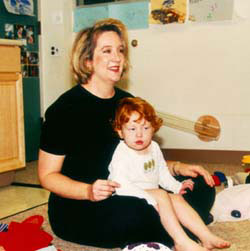Communicating with Infants and Toddlers through Music
After kicking off her shoes, Lori Custodero, Assistant Professor of Music Education, hops over the small gate that separates the children's playroom from the hallway in the Rita Gold Early Childhood Center at TC.
Squeals of delight come from inside the room. The first thing they see is the flower-patterned duffel bag of music-related playthings that Custodero brings into room. The children, who are between 7 months and 2 years old, excitedly tug on the bag in anticipation. When she puts it down, two-year-old Kiley and several others carefully unzip it, peek inside, and pull out several egg-shaped maracas.
Even though most of them cannot yet talk, the group of seven children requested the song "La Bamba," by choosing the little maracas out of Custodero's magical bag, and pointing to the CD player. She knows what they are trying to say. They shake them happily to the beat of the music. Instantly the young musicians are smiling and having a good time-they are, as Custodero says, "engaged."
Once a week, Custodero and her students meet with two separate age groups of children, infants and toddlers. In this setting, research intersects with practice as students and faculty members work directly with the children, watch them from the observation room, and videotape the class for future study.
This may sound like all business, but it actually provides a lot of enjoyment for both the children and the adults involved, said Professor Susan Recchia, Faculty Director of the Rita Gold Child Center. Recchia often videotapes the classes and hopes to work with Custodero on how music relates to non-verbal communication and the socializing patterns of the infants and children.
In the last five years, the Center has expanded from one to three classes, said Recchia. An observation room in between two of the classrooms allows researchers to watch without being seen. Observing the children in the weekly music class brings out a side of them-their social experience-which observers wouldn't normally see.
"Even though she only comes once a week for a half hour, it's salient to them, and they continue to create the musical context," said Recchia. "There is always one novel activity in addition to the regular repetition of the class."
It is apparent from the moment that the music starts that everyone is involved in this exciting weekly lesson. Although many of the children haven't developed verbal language, they can express their choices for musical activities based on which instruments, books, or other objects like scarves or mirrors, they pick out of Custodero's bag.
"The music class incorporates emergent learning opportunities such as working with language and words even if they can't use them yet," said Recchia.
She said that Custodero "scaffolds" the music class allowing the children to bring to the class whatever skills they have while allowing them to make choices at the same time.
She added that this class is inclusive, which means that children with special needs are integrated into the classroom. It works very naturally since the children are not all the same age and they are taught with individualized attention.
The children participate with a specially chosen and eclectic mix of songs and games that allows Custodero and Recchia to study their cognitive development. The songs and games in the music class incorporate the simultaneous use of many senses-touch, hearing, seeing.
"The job of these children right now is to use these modalities to make sense of the world," Custodero said.
When adults communicate with infants, we talk to them in musical ways, quite different from the way we speak to older people, she said. "Our voices tend to be higher in pitch, have a greater range of highs and lows, and are more lyrical." She asks, "Have you ever heard someone talk to a baby using a monotone voice?"
"Many of the qualities of what is often called 'motherese' are similar across countries and cultures," said Custodero. "Infants respond to musical communication, and adults instinctively know this. The universal nature of musical expression speaks to its significance in the lives of infants and caregivers."
Using the chant "Five Little Monkeys," Custodero was able to teach 12- to 14-month-old children a sequence of gestures related to the song before they could even talk. She believes this is what children find compelling about music-they can make order from it, and non-verbally express that structure.
Through the music activities, Custodero is able to study the children's "flow experience." She said flow is studying how the children keep themselves challenged in order to keep learning new skills. She watches how the infants initiate and sustain their interest through engagement with music.
Indications of flow often involve children's transformation of the musical activities. For instance, in the peek-a-boo song, Kiley began to play "peek-a-boo," hiding her toes rather than just hiding her head. She changed the game on her own to make it more exciting and personally relevant.
Kiley will be moving up to the toddler room in the fall. Custodero, who has been tracking the musical lives of many of the children at the Center for the last three years, looks forward to seeing how Kiley and her peers will continue to teach us about how children think and communicate through music.
Published Monday, May. 20, 2002

